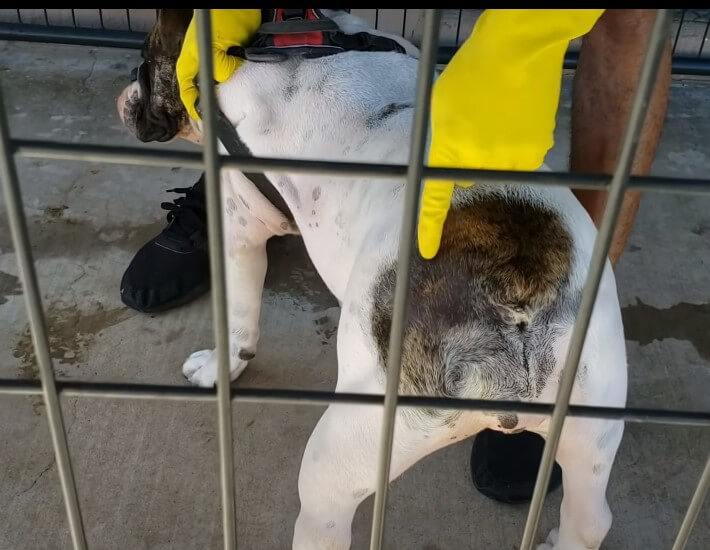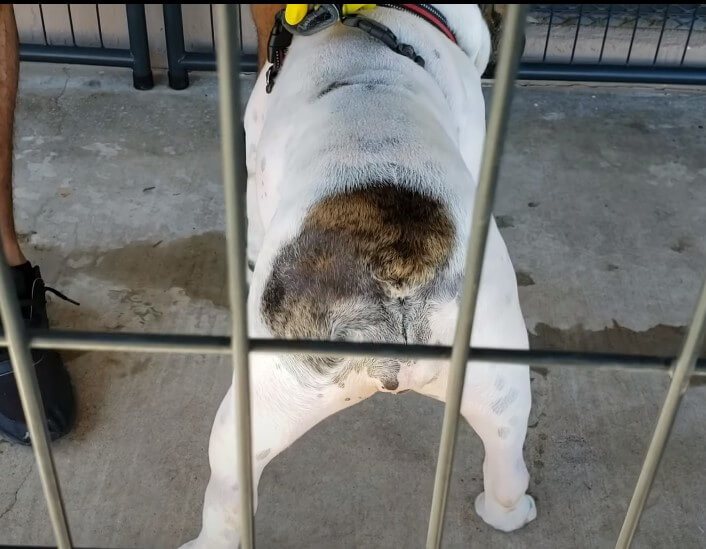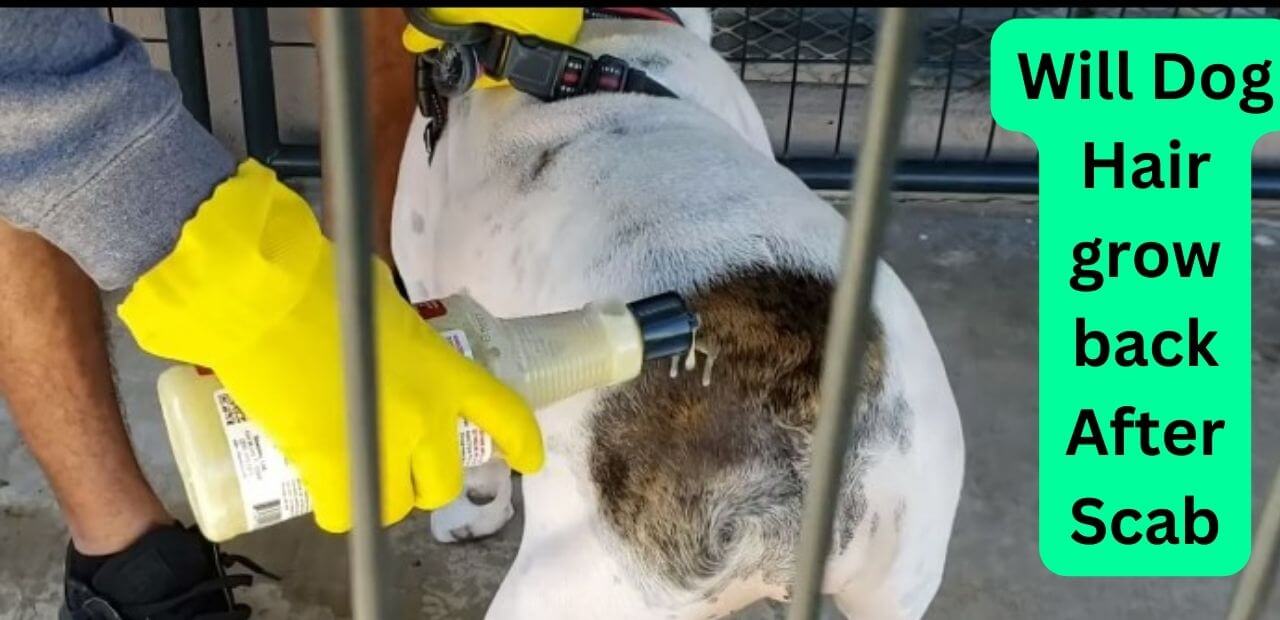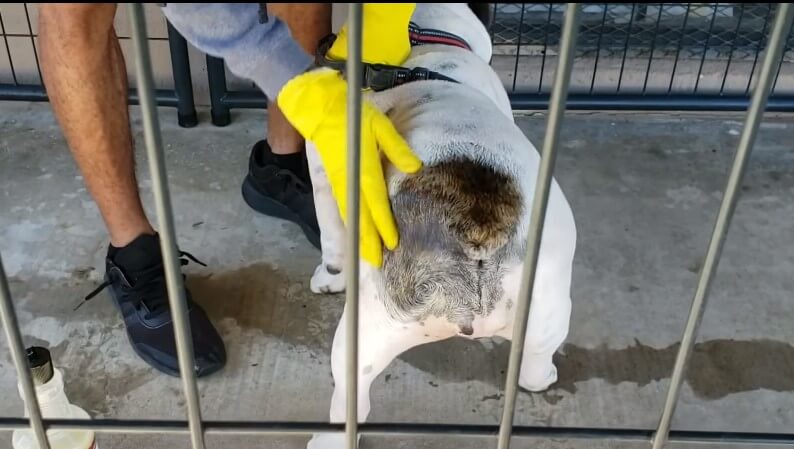Are you wondering if your dog’s hair will grow back when it scabs? We shall solve the puzzles about dog hair regrowth after scabs in this blog post. Will Dog Hair grow back After Scab? The Answer Is Yes, dog hair will typically grow back after scab formation. When a dog gets a scab, it is usually a sign of a healing wound.
As the wound heals, new hair will often start to grow in the affected area. However, the hair growth process can vary depending on the severity of the scab and the individual dog’s healing ability. It is important to keep the area clean and allow it to heal naturally to promote proper hair growth.
In some cases, dog hair may grow back differently, such as a different texture or color, but it is typically temporary and will eventually return to normal.
Will Dog Hair grow back After Scab
It can be upsetting to see our cherished animal companions afflicted with scabs, and it’s only natural to question if their coats will ever look the same.
Generally speaking, a dog’s hair does regrow after a scab, which is wonderful news.
The extent of the injury and the dog’s particular capacity for healing both affect the regrowth process.
For minor wounds, hair normally grows back within a few weeks, but for more severe wounds, it could take many months.
Our canine friends may preserve their gorgeous coats by receiving proper wound care, a balanced diet, and frequent grooming. This will help to promote healthy and glossy hair regeneration.
How Long For Dogs Hair To Grow Back After Scab
After a scab, the length of time it takes for a dog’s hair to regrow mostly relies on how bad the wound was and how quickly the dog heals on his or her own.
In minor cases, where the scab forms due to a superficial cut or scratch, hair regrowth may begin within a couple of weeks.
However, more significant injuries or underlying health conditions can extend the regrowth period to several months.
Proper wound care, a balanced diet, and regular grooming can all play essential roles in facilitating faster and healthier hair regrowth.
Consulting a veterinarian can help you get personalized assistance to make sure your pet friend’s coat heals properly.
Understanding The Science Behind Dog Hair Regrowth
With dog hair scabs being a common concern among pet owners, understanding the science behind dog hair regrowth can provide valuable insights.

Factors influencing dog hair regrowth, the role of the hair follicle in the regrowth process, and exploring the different stages of the hair growth cycle are all key aspects to consider.
Factors Influencing Dog Hair Regrowth:
- Genetics: The genetic makeup of a dog plays a significant role in determining the speed and quality of hair regrowth. Some breeds have a faster regrowth rate compared to others.
- Nutrition: Providing a balanced diet rich in essential nutrients is crucial for promoting healthy hair regrowth. Nutritional deficiencies can lead to delayed or inadequate hair regrowth.
- Health conditions: Underlying health conditions, such as hormonal imbalances, allergies, or immune disorders, can impact the regrowth process. Treating these conditions is essential for stimulating hair regrowth.
The Role Of The Hair Follicle In The Regrowth Process:
- Hair follicles: Hair follicles are the structures responsible for hair growth. When hair is damaged or falls out, the hair follicles remain dormant until triggered to start the regrowth process.
- Miniaturization: During the regrowth process, hair follicles may go through a phase of miniaturization, where the new hair may appear thinner and shorter. This is a normal part of the regrowth cycle and should not cause concern.
Exploring The Different Stages Of The Hair Growth Cycle:
- Anagen phase: This is the active phase of hair growth, where the hair follicle produces new hair. This phase can last for several years, depending on the breed and individual dog.
- Catagen phase: After the anagen phase, hair enters the catagen phase, where growth stops, and the hair follicle begins to shrink. This phase lasts for a brief period.
- Telogen phase: Also known as the resting phase, this is when the hair follicles are inactive and the hair is shed. The duration of the telogen phase varies from a few weeks to a few months.
- Exogen phase: During this phase, the old hair is shed to make way for new hair growth. Shedding is a normal part of the hair growth cycle and allows for the regrowth of healthy hair.
Understanding the science behind dog hair regrowth can give pet owners peace of mind when dealing with scabs and hair loss.
By addressing the factors influencing regrowth, recognizing the role of hair follicles, and being aware of the stages of the hair growth cycle, pet owners can take appropriate measures to promote healthy and sufficient hair regrowth in their furry friends.
How Scabs Affect Dog Hair Regrowth
Scabs on a dog’s skin can be a cause for concern for pet owners. Along with potential discomfort and itchiness, many wonder if the presence of scabs will hinder the regrowth of their dog’s hair. We’ll explore the topic of how scabs affect dog hair regrowth.
By understanding the formation of scabs on dogs’ skin and their impact on hair follicles, we can gain insight into whether scabs can impede the regrowth of hair. So, let’s delve into this topic further.
The Formation Of Scabs On Dogs’ Skin:
- Scabs form as a natural part of the healing process when dogs experience skin injuries or irritations.
- These injuries can be caused by various factors, such as external parasites, allergies, infections, or even excessive scratching.
- When a dog’s skin is damaged, platelets step in to form a clot that seals the wound. This clot eventually hardens to create a scab.
Impact Of Scabs On Hair Follicles:
- Scabs can affect the hair follicles beneath them, potentially leading to temporary hair loss.
- The presence of scabs can cause hair to become trapped or pulled out, interrupting the regrowth process.
- Additionally, scabs can lead to inflammation and irritation around the hair follicles, which may further impede the regrowth of hair.
Can Scabs Hinder The Regrowth Of Hair?
- While scabs themselves do not directly hinder hair regrowth, they can indirectly affect it through their influence on the underlying hair follicles.
- If a scab remains in place for an extended period, it may impede new hair growth by preventing the follicles from properly nourishing and supporting hair production.
- However, once the underlying cause of the scabs is addressed and the healing process is complete, the hair follicles can resume their normal function, allowing hair to regrow.
Remember, each dog’s situation may differ, and it’s essential to consult with a veterinarian for a proper diagnosis and treatment plan.
Understanding the formation of scabs and their impact on hair follicles can help dog owners make informed decisions when it comes to their furry friends’ skin health and regrowth potential.
The Healing Process: From Scab To Regrowth
Dogs are playful creatures, often finding themselves with minor injuries such as cuts or scratches. If your furry friend has developed a scab, you may be wondering if their hair will grow back. The healing process can be fascinating, as it involves various stages that contribute to the regrowth of your dog’s hair.

We will explore each step, from scab formation to hair follicle activation and regrowth initiation. So let’s dive into the world of dog hair healing!
Step-By-Step Guide To The Healing Process
Step1: Scab Formation And Wound Protection
- When your dog gets a wound, a scab forms as part of the natural healing process.
- The scab acts as a protective barrier, preventing bacteria from entering the wound and allowing the underlying tissues to regenerate.
- It is essential not to disturb or pick at the scab, as this can impede the healing process.
Step 2: Cellular Repair And Tissue Regeneration
- Underneath the scab, cellular repair takes place, and tissues start to regenerate.
- Specialized cells called fibroblasts produce collagen to rebuild the damaged area.
- Blood vessels deliver oxygen and nutrients to nourish the healing tissues.
- As the wound heals, you may notice the scab becoming smaller and less prominent.
Step 3: Hair Follicle Activation And Regrowth Initiation
- Once the wound has fully healed, the hair follicles surrounding the affected area begin to activate.
- The hair follicles produce new hair strands, initiating the regrowth process.
- Initially, the new hair may appear fine and sparse, but with time, it will thicken and regain its normal appearance.
- The regrowth process may vary in duration depending on the size and severity of the initial wound.
Understanding the healing process from scab formation to regrowth initiation can provide reassurance and insight into the recovery of your dog’s hair. Remember to provide proper wound care and avoid interfering with the scab formation. With patience and care, your furry friend’s hair will eventually grow back, restoring their adorable appearance.
Common Factors Affecting Dog Hair Regrowth After Scab
Scabs on a dog’s skin can be a common occurrence, particularly if your furry friend has been scratching or has had an injury. However, many dog owners wonder if their pet’s hair will grow back after a scab forms. The regrowth of dog hair is influenced by several factors, including nutrition, environmental conditions, and underlying health conditions.
Let’s take a closer look at each of these factors and their impact on hair regrowth.
Nutrition And Its Impact On Hair Regrowth
The saying “you are what you eat” holds true for our canine companions as well. A nutritious diet plays a vital role in promoting healthy hair regrowth. Here are some key points to consider:
- A diet lacking essential vitamins and minerals can lead to poor coat quality and hinder hair regrowth.
- Nutrients such as biotin, omega-3 fatty acids, and zinc are crucial for maintaining a healthy coat and promoting hair growth.
- Consult with your veterinarian to ensure your dog’s diet includes the right balance of nutrients for optimal hair regrowth.
Environmental Factors That Hinder Or Promote Regrowth
The environment your dog is exposed to can significantly impact hair regrowth. Consider the following factors:
- Excessive exposure to sunlight may cause damage to the hair follicles and hinder regrowth.
- Harsh chemicals or irritants, such as certain shampoos or topical treatments, can also impede the regrowth process.
- Maintaining a clean and hygienic living environment, free from pests and allergens, promotes healthy hair regrowth.
The Effect Of Underlying Health Conditions On Regrowth
Underlying health conditions can interfere with the regrowth of your dog’s hair. Here are a few key considerations:
- Allergies, infections, or hormonal imbalances can disrupt the normal regrowth pattern.
- Conditions like mange or alopecia can cause hair loss and, in some cases, prevent regrowth.
- Seeking veterinary advice and addressing any underlying health issues is essential for promoting hair regrowth.
While every dog is unique, ensuring proper nutrition, creating a favorable environment, and addressing any underlying health conditions are essential steps in helping your furry friend’s hair regrow after a scab. Monitoring and providing the necessary care will give your dog the best chance for a healthy and lustrous coat.
Promoting Dog Hair Regrowth: Best Practices
Scabs are a natural part of the healing process when your furry friend has a wound. But what may be lingering in your mind is whether your dog’s hair will grow back after the scab falls off. Don’t worry, promoting dog hair regrowth is possible with proper care and attention.
In this section, we will explore the best practices to promote hair regrowth in your canine companion.
Proper Wound Care And Scab Management Techniques
Taking care of your dog’s wound and managing the scab properly play a crucial role in promoting hair regrowth. Here are some key points to consider:
- Keep the wound clean by gently washing it with a mild antiseptic solution. Use a clean cloth or sterile gauze to pat it dry.
- Avoid picking or scratching the scab, as it could disrupt the healing process and delay hair regrowth.
- Applying a veterinarian-recommended topical ointment or cream on the wound can help accelerate healing and encourage hair regrowth.
- Keep your dog from licking or biting the affected area by using an Elizabethan collar or covering the wound with a protective bandage.
Essential Nutrients For Healthy Hair Regrowth
A balanced diet rich in essential nutrients is vital for promoting hair regrowth in dogs. Consider these key points:
- Protein is essential for hair growth, so make sure your dog’s diet includes high-quality protein sources such as lean meats or fish.
- Omega-3 fatty acids are known to enhance coat health and stimulate hair follicles. Add fatty fish, flaxseeds, or fish oil supplements to your dog’s diet.
- Vitamins a and e contribute to healthy skin and hair. Incorporate foods like carrots, sweet potatoes, and leafy greens into your dog’s meals.
- Consult with your veterinarian about the appropriate dosage of supplements like biotin or zinc, which can support hair regrowth.
Natural Remedies And Treatments To Encourage Regrowth
If you prefer a more natural approach to promoting hair regrowth in your dog, consider these options:
- Massaging the affected area with coconut oil or aloe vera gel can soothe the skin and stimulate hair follicles.
- Regular brushing improves blood circulation and promotes hair regrowth. Use a soft brush or a grooming tool specifically designed for dogs with sensitive skin.
- Herbal remedies like chamomile or calendula can have anti-inflammatory and healing properties. Consult with a holistic veterinarian for their recommendations and proper usage.
By following these best practices and giving your furry friend the care they need, you can help stimulate hair regrowth and restore their luscious coat.
Remember, patience is key, as hair regrowth may take time. Ensure proper wound care, provide essential nutrients, and explore natural remedies to support the process.
When To Seek Veterinary Assistance For Hair Regrowth Issues
Signs That Indicate A Need For Professional Intervention
If your dog’s hair is not growing back after a scab, it can be concerning. While some cases of hair loss and slow regrowth can be attributed to normal healing processes, there are certain signs that indicate a need for professional intervention.
These signs include:
- Prolonged hair loss: If your dog’s hair has not started to grow back within a reasonable amount of time, it is best to consult a veterinarian. This could indicate an underlying issue that requires further investigation.
- Inflamed or infected skin: If the skin surrounding the scab appears red, swollen, or oozing with discharge, it may be a sign of infection. A veterinarian can determine the cause and provide appropriate treatment.
- Changes in behavior or discomfort: If your dog is excessively licking, scratching, or rubbing the area, it could indicate discomfort or pain. Seeking veterinary assistance can help alleviate your dog’s discomfort and address any underlying issues.
Diagnostic Tests To Identify Potential Underlying Causes
When it comes to identifying the underlying cause of slow hair regrowth, veterinarians employ various diagnostic tests. These include:
- Skin scraping or cytology: This test involves taking a small sample of the affected skin to examine it under a microscope. It helps identify any presence of mites, fungi, or bacterial infections.
- Blood tests: A comprehensive blood panel can detect hormonal imbalances, nutritional deficiencies, or systemic diseases that may be contributing to the hair loss.
- Allergy testing: Allergies, both environmental and food-related, can cause hair loss and skin issues. Specialized tests can identify specific allergens that may be triggering your dog’s symptoms.
Treatment Options For Severe Hair Loss And Regrowth Difficulties
If your dog is experiencing severe hair loss or struggles with regrowth, several treatment options are available:
- Medications: Depending on the underlying cause, your veterinarian may prescribe medications such as anti-inflammatories, antibiotics, antifungals, or hormonal therapies.
- Topical treatments: Certain topical treatments like medicated shampoos or ointments may be recommended to soothe the skin, promote hair growth, or address underlying infections.
- Dietary changes: In some cases, a change in diet may be necessary to address nutritional deficiencies or food allergies. Your veterinarian may recommend a specialized diet or supplements to support hair regrowth.
- Laceration repair: If the hair loss is due to an injury or wound, your dog may require surgical intervention to promote proper healing and regrowth.
Remember, every dog’s situation is unique, and it’s crucial to seek veterinary assistance to properly diagnose and treat any hair regrowth issues. Professional intervention ensures the best possible outcome for your furry friend’s overall health and well-being.
Preventing Scabs And Promoting Healthy Hair Regrowth
Scabs on dogs can be a worrisome sight for pet owners. These crusty patches of dried blood and skin can not only be unsightly but can also lead to hair loss. The good news is that with proper care and attention, dog hair can grow back after scabbing.
In this section, we will discuss effective measures to prevent scabs and minimize hair loss, regular grooming practices for maintaining a healthy skin and coat, and long-term strategies to support continuous hair regrowth.
Effective Measures To Prevent Scabs And Minimize Hair Loss:
- Keep your dog’s skin moisturized by using dog-friendly moisturizers or coconut oil.
- Make sure your dog’s diet is well-balanced, with essential nutrients for skin and coat health.
- Protect your dog from allergies and external irritants by using hypoallergenic bedding, avoiding harsh chemicals, and keeping them away from known allergens.
- Regularly check your dog’s skin for any signs of irritation or potential issues.
Regular Grooming Practices For Maintaining Healthy Skin And Coat:
- Brush your dog’s coat regularly to remove loose hair, distribute natural oils, and prevent matting.
- Use a shampoo specifically formulated for dogs to keep their skin clean and healthy.
- Trim your dog’s nails to prevent scratching and potential injuries.
- Clean your dog’s ears regularly to avoid infections and irritation.
Long-Term Strategies To Support Continuous Hair Regrowth:
- Consult with your veterinarian to determine any underlying health issues that may be contributing to hair loss.
- Follow a regular grooming schedule to maintain the health of your dog’s skin and coat.
- Provide a balanced and nutritious diet that includes essential vitamins and minerals for hair growth.
- Consider supplements that promote coat health, such as omega-3 fatty acids or biotin.
By implementing these preventive measures, following regular grooming practices, and incorporating long-term strategies, you can help prevent scabs and promote healthy hair regrowth in your furry companion. Remember to consult with your veterinarian for any specific concerns or persistent issues.
With proper care, your dog’s hair will bounce back and regrow beautifully.
Frequently Asked Questions
How Long Does It Take For Dog Hair To Grow Back After A Scab?
After a scab forms, it may take anywhere from 2 to 3 weeks for new hair growth to occur. The exact time may vary depending on various factors such as the size of the scab and the overall health of the dog.
Will The Hair Grow Back If A Scab Is Picked Or Scratched?
If a scab is picked or scratched off prematurely, it can delay the healing process and potentially cause scarring. It is important to let the scab heal naturally to give the hair follicles enough time to regenerate and allow new hair growth.
What Can I Do To Promote Hair Regrowth After A Scab?
To help encourage hair regrowth after a scab, ensure proper nutrition with a balanced diet, provide regular grooming to stimulate blood flow to the skin, and consult with a veterinarian for any potential underlying health issues that may be interfering with hair growth.
Are There Any Home Remedies Or Treatments To Speed Up Hair Regrowth?
While there are some home remedies and over-the-counter treatments that claim to promote hair regrowth, it is best to consult with a veterinarian before trying any of these options. They can provide guidance based on the specific needs and condition of your dog.
Should I Be Concerned If Hair Doesn’t Grow Back After A Scab?
If hair doesn’t grow back after a scab has healed, it is advisable to consult with a veterinarian. There may be underlying issues such as allergies, infections, or hormonal imbalances that need to be addressed to promote healthy hair regrowth.
Can Frequent Scab Formation Lead To Permanent Hair Loss In Dogs?
Repeated scab formation without proper healing can potentially lead to permanent hair loss in dogs. It is essential to address any underlying issues causing scab formation and seek veterinary advice to prevent further damage to the hair follicles.
Conclusion
To summarize, it is normal for dog hair to grow back after a scab form, but the process may vary depending on several factors. will a dog’s hair grow back after a scab? The length of time it takes for hair to regrow can range from a few weeks to several months.
While it can be tempting to try speeding up the process, it is important to let nature take its course and allow the body to heal properly. Proper grooming, a nutritious diet, and regular veterinary check-ups are essential to maintaining a healthy coat and promoting hair regrowth.
Remember to be patient during this process hair growth is a gradual and natural occurrence. And, if you notice any abnormal or persistent hair loss, consult with your vet to rule out underlying health issues. By providing your furry friend with the care they need, you can help ensure that their hair grows back beautifully.
- Smelly House Because of Dog? Take These Hygiene Tips - May 20, 2025
- How to Introduce a Dog To a Cats Without Chaos - May 6, 2025
- 4 Best Cavapoo Rescues in the UK 2024 - April 5, 2024









